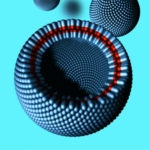 Researchers at Saarland University in Saarbrücken, Germany have developed cell-like vesicles made from a bilayer of naturally occuring proteins that can be used in an aqueous or an oil-based environment.
Researchers at Saarland University in Saarbrücken, Germany have developed cell-like vesicles made from a bilayer of naturally occuring proteins that can be used in an aqueous or an oil-based environment.
The team was characterizing naturally occurring proteins called hydrophobins when they observed a strange behavior.
“We noticed that the hydrophobins form colonies when they are placed in water. They immediately arrange themselves into tightly packed structures at the interface between water and glass or between water and air,” professor of condensed matter physics Karin Jacobs said in prepared remarks. “There must therefore be an attractive force acting between the individual hydrophobin molecules, otherwise they would not organize themselves into colonies.”
Using 4 intersecting flow channels, the researchers flowed a stream of oil from one side of the crossing to the other. In the other 2 channels, they injected water which met in the middle of the crossing. The hydrophobins were arranged at the water-oil interface and the team forced the flowing water together to observe the attractive force.
“At some point the 2 aqueous fingers suddenly coalesced to form a single stable interface consisting of 2 layers,” study co-author Ralph Seemann explained. “The weird thing is that it also functions the other way around, that is, when we use oil fingers to interrupt a continuous flow of water,”
The researchers report that this is the 1st time a molecule has exhibited this behavior in both water and oil-based environments. Normally, they said, proteins will either orient themselves with hydrophilic (water-loving) parts in contact with an aqueous medium or with their hydrophobic (water-fearing) side in contact with oil.
Finally, they reconfigured the stable bilayer and formed a small, stable, cell-like vesicle. They successfully incorporated ion channels into the vesicles, which allows charged particles to be transported through the bilayer of hydrophobins.
“Essentially we are throwing a vesicle ‘cape’ over the drug molecule,” study co-author Hendrick Hähl explained. “And because the ‘cape’ is composed of naturally occurring molecules, vesicles such as these have the potential to be used in the human body.”
Jacobs and her team envision using the vesicles for targeted drug delivery, like transporting molecules that would normally lose their stability in water through an aqueous medium.
“The ‘discovery’ of these vesicles is archetypal of this kind of fundamental research,” Jacobs said. “Or to put it another way, if someone had said to us at the beginning: ‘Create these structures from a natural bilayer,’ we very probably wouldn’t have succeeded.”

